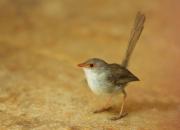info
We had to spend a few hours to take the pictures presented here. Although there was no need to chase the birds in the woods but in the bushes, where shooting them took me the longest, it was hard to keep up with them as they were very dynamic. A few hours seems to be a lot in terms of Australia where I could get used to shooting almost every moment some new species. It is no problem to become accustomed to easier shooting conditions. In Poland it happened many times that the "trip" ended up with blank card. In Australia such situation is improbable, what is more without any camouflaging, lookouts. But there was an additional difficulty in photographing the Fairywren, it was its size. It is a bit smaller than our wren, because its weight does not exceed 14 grams and a wingspan 13 centimeters, and it is lively indeed. It is impossible to predict in which direction it will move so you have to watch it off-camera then quickly try to focus and take the picture. I was sitting almost motionless not too far from the bushes in which the Fairywrens were, after half an hour – three quarters of an hour they got confident and appeared much closer to me making it easier to take pictures. Especially females, but they were not particularly those I was striving for. So, it cost me a little hassle but it was worthwhile. This dainty bird, especially males, in close-up shows its charm. Sexual dimorphism is very clear and as usually males are more colorful than females. The Superb Fairywrens can have up to three broods a year. Crimson rosellas coming there now and then seemed huge compared to fairywrens. Going further into the forest I managed to take more interesting photos, including a few shots of the Kookaburra which will appear in the news soon.
Australia - wykaz j.angielski
A U S T R A L I A – introduction text - A U S T R A L I A N B U S T A R D
News gallery birds:
1.Australian bustard.2.Emu.3.Red-tailed Black-Cockatoo.4.White-faced Heron.5.Brolga.6.Green Figbird.7.Zebra Finch.8.Rainbow Lorikeet.9.Pheasant Coucal.10.Australian Pelican.11.Olive-backed Sunbird.12.Yellow Honeyeater.13.Apostlebird.14.Magpie Goose.15.Superb Fairywren. 16.Sulphur-crested Cockatoo.17.Noisy Friarbird.18.Straw-necked Ibis.19.Welcome swallow.20.Black Kite.21.Gala. 22.Plumed Whistling Duck.23.Dollarbird.24.Sacred Kingfisher.25.Masked Lapwing.26.Varied triller.27.Little friarbird. 28.Black-shouldered Kite.29.Laughing Kookaburra.30.Comb-crested jacana.31.Sharp-tailed sandpiper.32.Red-whiskered Bulbul.33.Peaceful Dove. 34.Bush stone curlew. 35.White-throated honeyeater.36.Australian Brushturkey.37.Noisy miner.38.New Holland Honeyeater. 39.Crimson Finch. 40.White-breasted Woodswallow.41.Australian King Parrot.42.Australian Wood Duck.43.Great Bowerbird.44.Little Pied Cormorant.45.Black-billed Koel.46.Australian Raven.47.Spangled drongo.48.Spiny-cheeked honeyeater.49.Willie Wagtail.50.Wedge-tailed Eagle.51.Common Myna.52.Lewin's Honeyeater.53.Eastern Spinebill.54.Chestnut-breasted Munia.55.Rainbow Bee-eater. 56.Blue-winged Kookaburra.57.Common bronzewing.58.Wandering whistling duck.59.Helmeted Friarbird.60.Crested Pigeon.61.Pied Currawong.62.Brown-backed honeyeater.63.Yellow-faced honeyeater.64.Grey-headed honeyeater.65Yellow-throated miner.66.Scaly-breasted munia.67.Masked Woodswallow.68.Hardhead.69.Pale-headed Rosella.70.Blue-faced Honeyeater.71.Grey Butcherbird.72.Australian magpie.73.Whistling kite.74.Black Swan.75.Royal Spoonbill.76.Double-barred Finch.77.Broad-billed Flycatcher.78.Australian Swamphen.79.Brown Falcon.80.Pied Butcherbird.81.White-browed scrubwren.82.Silvereye.83.Rufous-throated Honeyeater.84.Black-faced Cuckooshrike. 85.Red backed fairywren.86.Pacific black duck. 87.Magpie-lark. 88.Red winged parrot.89.Zitting Cisticola.90Cotton Pygmy Goose.91.Pallid Cuckoo. 92.Australian Kestrel.93.Crimson Rosella.94.Forest Kingfisher.95.Australian coot.96.Red-browed Finch.97.Australian White Ibis.98.Australasian Darter.99.Pied oystercatcher.100.Striated Heron.101.Cattle Egret.102.Great Egret.103.Intermediate Egret.104.Sooty Oystercatche.105.Green pygmy goose.106.Brush Wattlebird.107.White-heded Stilt.
News gallery reptiles:
1.Yellow Spotted Monitor. 2. Eastern blue-tongued lizard. 3.Jewel Rainbow. 4.Sand Monitor. 5.Nobbi Dragon. 6.Saw-shelled turtle.
News gallery mammals:
1. Dingo. 2. Flying fox. 3. Agile wallaby. 4. Eastern grey kangaroo. 5.Common wallaroo. 6.Whiptail Wallaby.
Go to the gallery: A U S T R A L I A – F A U N A


